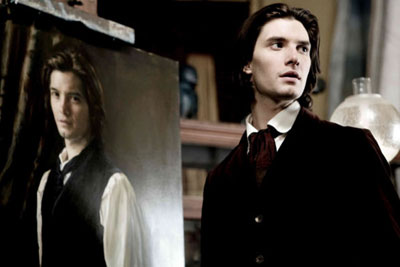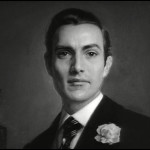Everything New Is Old Again: Dorian Gray Films, Past and Present
Published on November 8th, 2011 in: Books, Movies, Reviews |By Lisa Anderson
I recently re-read The Picture of Dorian Gray, Oscar Wilde’s novel about a beautiful but debauched young man whose enchanted portrait takes the brunt of both his years and his misdeeds. Soon afterwards, I got together with a group of fellow horror fans and watched two film adaptations: the1945 Albert Lewin version with Hurt Hatfield in the title role, and the 2009 direct-to-video version with Ben Barnes starring as Dorian. Not surprising in light of the time between them, both movies approach the source material in very different ways. Each deviates from the novel in different ways, and has its own strengths and weaknesses. The variations between the book and each film can be illustrated by discussion the tone of the films, and two pivotal incidents in the story.
As might be expected, the 1945 version of The Picture of Dorian Gray is far subtler than its twenty-first century descendant. The Victorian London depicted in the Lewin film is mundane in the literal sense. Everything seems normal, even pleasant where it might be expected. This makes the parts that are supposed to be unsettling even more so. By contrast, the 2009 movie pulls out every stop, from musical cues to a Dickensian take on Whitechapel, to make sure that you understand that everything is creepy. Just as an example, in the 1945 version, the portrait, once it has started to change, is stored in an old schoolroom in Dorian’s mansion. In the 2009 version, it’s exiled to an abandoned wing of the house, where the walls are crumbling and peeling and there are rats running around.
The portrait itself demonstrates how the movies are different from each other. In both cases, it of course ends up looking way worse than you’d expect a evil old man to look. But in Dorian Gray (2009), the picture moves, even growls and whispers in the middle of the night. In the earlier film it remains a still portrait . . . but is the only part of the movie that’s in color.
Even the means by which Dorian becomes bound to the portrait are different. In the older film, a statue of an “Egyptian God” is present when Dorian makes his wish that the painting should age instead of him. (The statue is of Bast, by the way, but that’s neither here nor there.) In Dorian Gray, Dorian echoes the words of his new friend Henry Wotton, and unintentionally sells his soul. Neither way is exactly like the book, where Dorian’s rash wish comes true on its own.
Both movies take liberties with critical events from Wilde’s novel. In the book, Dorian’s fiancée, actress Sibyl Vane, kills herself after he cruelly rejects her. This is where we see him start to become hedonistic and hard-hearted. The 1945 film made this the result of an experiment suggested by Henry Wotton. Dorian propositions her sexually, defying the morality of the time, only to be disappointed in her for giving into his own emotional blackmail.

Dorian Gray, 2009
In Dorian Gray, Dorian doesn’t think any less of Sibyl for happily going to bed with him, but gets panicky at the prospect of becoming both a husband and a father in short order. (Apparently marriage is one thing but babies are another.) I don’t like either of these interpretations as well as I like the original text. In the book, Dorian dumps Sibyl because she is so distracted by love that she turns in a bad performance when he brings his friends to see her act. The movies make her into a sex object, with sex at the center of their conflict, while the book treats her as an artist. This is more consistent with the prominence of art as a theme in the novel. The Dorian of the book loved Sibyl more as an artist than as a person.
Wilde’s story deals with issues of sexuality, but the violence in it is equally important. Here, too, the movies differ from each other and from the novel. Dorian murders the painter of the portrait, Basil Hallward, after he gets a glimpse of his corrupted work. In the older movie, however, as in the book, this happens years after the portrait is painted, when Hallward confronts Dorian about his reputation. Once the deed is done, Dorian blackmails a friend into destroying the body for him. (Considering the tragic facts of Wilde’s life, I think I know what Dorian had on him.)
In Dorian Gray, it happens after less than a year, when Hallward demands an explanation for why he can’t borrow the painting and exhibit it. More importantly, in that film, Dorian disposes of the body himself, dismembering and throwing it into the Thames. This change obscures an important point made by Wilde. Dorian’s choice to involve someone else in the murder added another layer of selfishness to his character. In the novel, he is unable to deal with the corpse himself because it’s something ugly and unpleasant.
In the end, Wilde’s story has its own strange moral compass. It’s obvious—especially from the aphorisms that he puts in the mouth of Henry Wotton—that Wilde believed in drinking deeply of life, and in chalking up our setbacks and sins as experiences. I don’t, however, think he believed in running roughshod over other people to do it, on living life without compassion or connection.
At the end of the novel, Dorian destroys the now-unrecognizable painting, and all the wear and tear that he has been putting off falls on him at once, killing him. Both the 1945 and 2009 film end this way, too. Dorian embraces the cost of his actions both because it’s the right thing to do, and in order to protect someone else. In this way, both movies are true to the spirit of Wilde’s novel. They are starkly different treatments of this enduring work, but each has something unique to offer its fans.

Time limit is exhausted. Please reload the CAPTCHA.